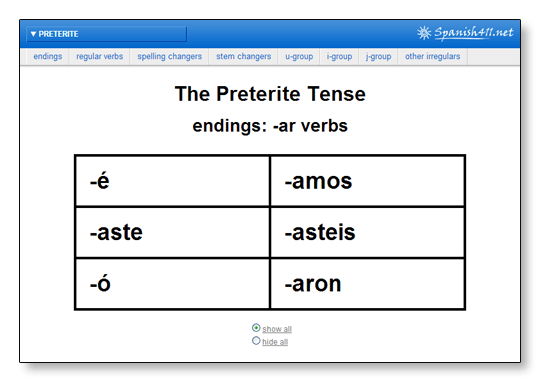|
|||||||||||||||||||||||||||||||||||||||||||||||||||||||||||||||||||||||||||||||||||||||||||||||||||||||||||||||||||||||||||||||||||||||||||||||||||||||||||||||||||||||||||||||||||||||||||||||||||||||||||||||||||||||||||||||||||||||||||||||||||||||||||||
 |
|||||||||||||||||||||||||||||||||||||||||||||||||||||||||||||||||||||||||||||||||||||||||||||||||||||||||||||||||||||||||||||||||||||||||||||||||||||||||||||||||||||||||||||||||||||||||||||||||||||||||||||||||||||||||||||||||||||||||||||||||||||||||||||
 |
|||||||||||||||||||||||||||||||||||||||||||||||||||||||||||||||||||||||||||||||||||||||||||||||||||||||||||||||||||||||||||||||||||||||||||||||||||||||||||||||||||||||||||||||||||||||||||||||||||||||||||||||||||||||||||||||||||||||||||||||||||||||||||||
The Preterite Tense
See also: Using the Imperfect and the Preterite. The Preterite Tense (also spelled “preterit”) is one of two ways to talk about events that happened in the past in Spanish. The preterite tense is used to indicate a single, completed action that took place at a specific point in time. For example: Armando me llamó a las nueve. Regresaron de España ayer. Olivia se fue esta tarde. Preterite conjugations can be pretty tricky due to the large amount of irregular verbs and some other complicated situations. To learn how to form preterite conjugations, keep reading. For more on when to use the Preterite Tense, see Using the Imperfect and the Preterite. Regular Preterite Tense VerbsTo conjugate regular “-ar” verbs in the preterite, take off the ending and add the following: “-ar” endings:
Don’t let the “-é” in the yo form throw you off; it’s still an “-ar” verb conjugation. It’s absolutely critical that the “o” in the él/ella/usted form conjugation get an accent mark so it isn’t confused with the present tense yo form conjugation. To conjugate regular “-er” and “-ir” verbs in the preterite, take off the endings and add the following: “-er” / “-ir” endings:
Here are some examples: hablar:
comer:
vivir:
 Let’s practice! Conjugate regular preterite tense verbs on ¡Practiquemos! Preterite Spelling Change VerbsThe yo form endings for “-ar” verbs occasionally cause pronunciation problems because some letters are pronounced differently depending on the vowels that follow them. The letters “c” and “g,” for example, sound different when they’re followed by an “a” or an “o” than when they’re followed by an “e” or “i.” Since the preterite yo form ending is an “e”, we need to change the spellings of the stems of “-car” verbs, “-gar” verbs, and “-zar” verbs in order to keep the pronunciation consistent. For example: tocar (c → qu):
jugar (g → gu):
lanzar (z → c):
Tocar has a “-que” ending in the yo form to keep the original “c” sound being pronounced like a “k” rather than like an “s.” Jugar now has a “-gue” ending to keep the original “g” sound pronounced like a “g” rather than like an “h.” And lanzar now has a “-ce” because, well… anytime we can use a “c,” we should. The “e” ending gives us an opportunity to do so. It doesn’t happen often, but “-guar” verbs will also require a spelling change. Take a verb like averiguar which means “to verify.” When we conjugate in the yo form of the preterite, we need to add a “dieresis,” which means the “u” becomes a “ü”: Yo averigüé
los datos ayer. The “ü” tells us to pronounce the “gu” like a “gw” so that our pronunciation will be consistent with the infinitive, averiguar. These spelling changes only happen for “-ar” preterite verbs and only in the yo form because the “-e” is the only ending that creates problems for the “c,” “g,” “z” and the “gu.” More Spelling ChangesCertain “-er” and “-ir” verbs are also going to need spelling changes to keep pronunciation consistent. This time around it’s the él/ella/Ud. and ellos/ellas/Uds. forms that cause problems. The endings for those conjugations are “-ió” and “-ieron.” Notice how they both start with two vowels? If we have a verb whose stem ends in a vowel, and then we add one of those endings, we’re going to end up with three vowels in a row. It’s difficult to pronounce a word with a three vowel combination. To solve that problem, we change the “i” to a “y.” Some common trouble making verbs conjugated in the ellos/ellas/Uds. form:
The él/ella/Ud. form conjugations will use the same spelling change. Here is a complete set of conjugations for some common verbs: Note: In addition to the caer:
leer:
oír:
As you can see, this “i” → “y” spelling change only occurs in the bottom row of conjugations. Note: Verbs ending in An exception to the “i” → “y” spelling change rule are “-guir” verbs and “-quir” verbs. While the stems do end in a vowel, the “u” is not actually being pronounced. Because of that, we can pronounce the three vowels in a row and a “y” is not necessary.
 Let’s practice! Conjugate preterite spelling change verbs on ¡Practiquemos! Preterite Stem Changing VerbsStem Changing “-ar” and “-er” VerbsAll “-ar” and “-er” verbs which have stem changes in the present tense are completely regular in the preterite, which is to say that they don’t have stem changes in the preterite. Notice how the stem does not change in any conjugation: pensar (e → ie):
perder (e → ie):
Stem Changing “-ir” VerbsStem-changing “-ir” verbs do have a stem change which is sometimes different from the present tense stem change; “e → ie” stem changers in the present tense become “e → i” stem changers in the preterite, “e → i” stem changers remain “e → i”, and “o → ue” stem changers become “o → u”:
However, this change only happens in the él/ella/usted form and the ellos/ellas/ustedes form: sentir (e → ie):
pedir (e → i):
dormir (o → ue):
In some books verbs like these will have special notations to let you know about the additional preterite stem change: sentir (e → ie, e → i), dormir (o → ue, o → u), etc. Because these additional changes only take place on the bottom line of the conjugation chart they are sometimes referred to as “basement buddies.”  Let’s practice! Conjugate preterite stem changing verbs on ¡Practiquemos! Irregular Preterite Tense VerbsThe “U” Group, “I” Group, and “J” GroupThere are many irregular preterite conjugations which have both stem changes (only in the preterite tense) and their own set of endings. It can be helpful to put them into groups to help you memorize them. The “U” GroupNote: Any verbs based on these irregular verbs have the same irregularities; imponer → inpus-, proponer → propus-, detener → detuv-, etc. Most of the irregular verbs have stem changes which involve the letter “u”:
The “I” GroupNote: Any verbs based on these irregular verbs have the same irregularities; convenir → convin-, prevenir → previn-, etc. There are a couple others with stem changes involving the letter “i”:
For both of these groups, the “u” group “i” group, there is a different set of endings:
Note that these endings are very similar to the “-ir” verbs with the exception of the yo and él/ella/usted forms, and that there are no accent marks needed. Some examples: saber:
tener:
venir:
 Let’s practice! Conjugate irregular preterite u- and i-group verbs on ¡Practiquemos! The “J” GroupNote: Any verbs based on these irregular verbs have the same
irregularities; There is one more group of stem changers, the “j” group:
The endings for the “j” group stems are almost identical to the “u”/“i”
Notice that there is no “i” in the ellos/ellas/ustedes form ending. Some examples: decir:
traer:
 Let’s practice! Conjugate irregular preterite j-group verbs on ¡Practiquemos! Other Irregular Preterite VerbsThere are several other completely irregular preterite verbs. Here are the conjugations for dar, hacer, ir, and ser: dar:
hacer:
ir:
ser:
Note: The verb satisfacer (to satisfy) follows the pattern of hacer: satisfice, satisficiste, satisfizo, etc. Even though dar is an “-ar” verb, it takes “-er” / “-ir” verb endings (minus the accent marks). If you look carefully, you’ll notice that hacer isn’t completely irregular (it could fit quite nicely the “i” group) but the need for consistent pronunciation forces us to use a “z” in the él/ella/usted form. That’s not a typo—the conjugations of ir and ser are identical—context makes the meaning clear. And there is one more (slightly) irregular preterite verb: ver:
The yo and él/ella/Ud. forms of ver do not have accent marks.  Let’s practice! Conjugate irregular preterite tense verbs on ¡Practiquemos! |
|||||||||||||||||||||||||||||||||||||||||||||||||||||||||||||||||||||||||||||||||||||||||||||||||||||||||||||||||||||||||||||||||||||||||||||||||||||||||||||||||||||||||||||||||||||||||||||||||||||||||||||||||||||||||||||||||||||||||||||||||||||||||||||
 This work by Spanish411.net is licensed under a Creative Commons Attribution-NonCommercial-ShareAlike 4.0 International License. This work by Spanish411.net is licensed under a Creative Commons Attribution-NonCommercial-ShareAlike 4.0 International License. |


